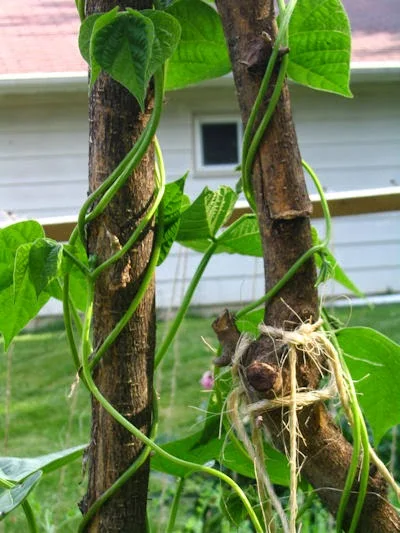Small Space Gardening and Other Edible Growing Strategies
 |
| Growing beans vertically |
Greening your outdoor spaces with more edible plants makes sense. A cost-analysis conducted by the Burpee Garden Seed Company (W. Atlee Burpee & Co.) back in 2008 showed that gardeners can net an up to 1 to 25 cost savings by producing their own home grown produce, even after buying extras like soil amendments. That makes fresh summer salads, autumn soups and impromptu stir fries a bargain. If you've paid a prohibitive sum for a couple of pale organic tomatoes, you probably already know backyard produce production is the way to go.
More than that, homegrown produce can be cultivated using fewer (if any) pesticides and other additives, and there are lots of vegetable and fruit varieties to choose from, including newer cultivars that are hardier, more pest resistant and produce bigger yields with less work. On the other end of the scale, you also have more control if you want to steer clear of GMOs and provide your family with heirloom seed stock not available in your average supermarket. You can harvest the crops you grow when they're ripe, too, and not on a large grower's schedule when they're transport ready but still green and rock hard. The U.S. Centers for Disease Control (CDC) even recommends growing your own produce as a healthy and inexpensive way to supplement your diet.
Let's take a look at a few smart, space saving planting strategies you can use this year:
Square Foot Gardening - Square foot gardening is the current darling approach to high-yield vegetable gardening for the casual grower. It relies on a nutrient rich growing medium to produce more vegetables and herbs in a smaller footprint. Less space can mean less work, too. If your soil is hard, rocky or nutrient poor, don't worry. Square foot gardens are installed in raised beds above the existing topsoil. That compacted clay won't be much of a problem, and after a few seasons of enhanced worm labor, may even show signs of improvement.
Gardening in Containers - Garden pots are getting a modern treatment with the addition of built-in water reservoirs. Extra water in reserve makes it easier to keep deck and patio plants hydrated during hot summer afternoons. If you've experienced wilted basil or brown cilantro in past seasons, this may be your year to plant a prolific patio garden without worrying about the H2O portion of the equation.
Going Up - The concept is easy: grow vertically not horizontally. This could be as simple as training squash or cucumber plants along a fence or pole, or involve a complex vertical mesh support system mounted to the side of a wall or fence. Vertical gardens can often support vegetable varieties you wouldn't expect to see picture frame style, like lettuce, basil and spinach.
More sophisticated vertical gardens can use any of a number of different growing media and support structures, but they typically require less spacing between plants than in traditional row or flowerbed gardens because water and nutrients are more readily available to to thirsty, hungry plant roots.
 |
| Watermelon grown on a straw bale. |
Straw Bale Gardening - You have to admit, gardening in a bale instead of a pot is a pretty ingenious idea. Straw is a perfect soilless growing medium -- so much so that some experts call it a method of outdoor hydroponics. You supply the water and fertilizer, and nature supplies everything else. You can easily install two tomato plants or three cucumber or pepper plants (or a combination) per bale, and even include small herbs like creeping thyme along the sides as a quasi-border. The bales are elevated, so they're super convenient if you have back or other mobility problems. For information about how I got started with straw bale gardening, visit my blog post: Straw Bale Gardening
Inverted Gardening - You've seen those plastic baskets designed to secure plants upside down. This potting method distributes water directly to -- rather than away from -- the plant roots, and keeps tender seedlings somewhat protected from pest infestations. Inverted gardening systems have a couple of drawbacks: If you're growing tomatoes, small determinate varieties do best, and you'll need to water a couple of times a day during high summer as moisture evaporates more quickly from the suspended soil ball. If you like the idea of maintaining a relatively effortless herb garden, this can be a fun way to start. Kids enjoy these inverted setups and can learn a lot about plant keeping pretty effortlessly.
Indoor Hydroponics - Growing herbs and vegetables indoors summer and winter can be easier and less expensive than you think. It's a whole new way to garden. Before another season passes you by, consider learning how to make your house your best garden microclimate. The free hydroponic magazine, "Maximum Yield" has great articles about how to start and maintain successful indoor gardens. You can visit their site, Maximum Yield, or pick up a copy at your local hydroponics outlet.

i always get excited about gardening. I only ever set out a fabulous buffet for woodchucks and rabbits and end up buying all my produce at the local Farmer's Markets. I suppose woodchucks and rabbits deserve to eat too.
ReplyDeleteOlga,
DeleteI agree they're greedy devils, but it's worth trying to foil them.
Sara